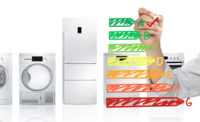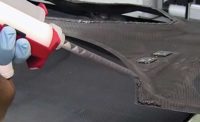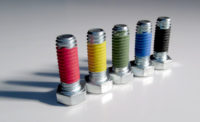For decades, appliance designers have used plastic materials to solve engineering challenges in design capabilities, labor and material costs. Polymeric materials can be used in a number of different applications, including refrigerator/freezer interiors, the outer drum in washing machines, and dishwasher racks and baskets. This trend is continuing to expand across the industry as more types of plastic materials and plastic components are incorporated into the designs of new appliance models.
There are several reasons plastic materials are considered for integration into new designs. For applications that have exposure to water, replacing steel parts with plastic components can reduce corrosion. This is particularly important in washers and dishwashers, where the use of soap or detergents increases the corrosive potential of water. The negative effects of corrosion can be addressed by coating steel or using stainless steel, but plastics are an effective material solution that can often reduce component cost.
Traditional method
Metals, particularly steel, have traditionally been used in appliances because the methods of metal assembly, such as welding, brazing and mechanical fasteners, are well understood and production-ready. Welding steel panels is a common practice in the appliance industry, and is increasingly being automated. Brazing metal components is often used for assembling sealed refrigeration systems. Fasteners, such as bolts, rivets and screws, are also a commonly used method for joining metals.
Mechanical fasteners are also commonly used to assemble plastic materials, attaching them to both metal components and to other plastic components. Bonding plastic materials poses different engineering challenges than bonding metal. Welding plastics (which is occasionally performed ultrasonically) is most effective when both plastic surfaces are exactly the same. Even then, it is not as routine or well-understood as welding steel. Similar to welding, using fasteners with plastic parts is a challenge. It is straightforward to mold holes for fasteners, but it is difficult to tap a threaded hole in plastic. Typically, a fastener attaching a plastic component must be anchored into a metal nut or plate.
Mechanical fasteners provide strong point bonds. However, the stress concentration around a single point can cause concern with plastic materials because plastic is not as strong as metal, making the spot of the fastener more subject to failure.
The benefits of adhesives
Using an adhesive to join components distributes stress across the entire width of the bond, therefore eliminating a point bond stress concentration. In addition to providing a secure attachment, using adhesives in appliance designs can simultaneously provide a tight water and moisture seal at the bond-line. In many designs, an adhesive can replace both a gasket and a series of fasteners along the length of a bond. An industry application example of this would be using an adhesive to attach a glass cooktop, in which case the adhesive provides both a bond and a seal.
Another significant benefit of adhesives is that many adhesives are designed to endure after the initial bond is formed. This is because these adhesives are viscoelastic, a property allowing them to have elastic resistance to stress as well as a viscous response to stress. The viscoelastic behavior of adhesives allows small levels of deformation when a stress is applied to the bond by the differential expansion and contraction of the materials bonded.
Replacing steel with plastic
When weighing the decision to use plastic materials for an appliance design, there are several important factors to consider. These factors require different considerations than the decision to use metal. First, the surface energy of the plastic material is a critical property that must be identified in order to enable the selection of an effective adhesive.
The surface energy of a material determines the degree to which an adhesive can wet-out onto its surface: the higher the surface energy, the more readily an adhesive will flow out onto it. Metals typically have high surface energies and are comparatively easy for an adhesive to wet-out. Plastic materials typically have lower surface energies, but there are several plastics that cover a broad range of surface energies.
Below is a chart with surface energy values for a range of common materials. The lower the surface energy of the plastic being bonded, the more important it is to select an appropriate adhesive. It is critical to select an adhesive that will wet-out on the plastic surface, otherwise a strong bond cannot be made.
Plastic materials have a larger coefficient of thermal expansion than metals; therefore they change size to a greater extent than metals in heating and cooling processes. These temperature variations occur often in appliances. The use of an appropriately selected viscoelastic adhesive for bonding metal to plastic will allow the two materials to change size in conjunction with the temperature change, while still maintaining a secure bond.
Another important benefit of the viscoelastic property is the ability to decrease vibration. The adhesive in a vibrating assembly is also subjected to the motion of the vibration, but the viscoelasticity of the adhesive helps reduce noise from vibration. This means that panels attached with adhesive are usually quieter than panels attached with rivets or screws.
An important consideration in adhesive selection for bonding plastic materials is the cost associated with accommodating limited options for varying dimension. Since plastic materials are typically molded or thermoformed, plastic parts often have greater variability in dimensional tolerances than metal parts. This can cause the gaps between parts to vary from unit to unit, presenting a challenge for mechanical fasteners. Some adhesives provide excellent gap-filling performance, allowing for the use of plastic components with less concern for the expense of reducing dimensional variability.
The adhesive advantage
Adhesive bonding in appliances, specifically with use of adhesives to bond plastic components, offers the design opportunity to provide a tight seal as well as a secure bond. Adhesives also create viscoelastic bond-lines that compensate for possible differential thermal expansion, as well as possible vibration of the bonded parts, and can allow for gap-filling to compensate in bonding parts with variable dimensional tolerances.
In selecting an appropriate adhesive to provide these design benefits, it is critical to consider the surface energy of the plastic parts to ensure that the adhesive selected will wet-out on the surface and form a bond.



